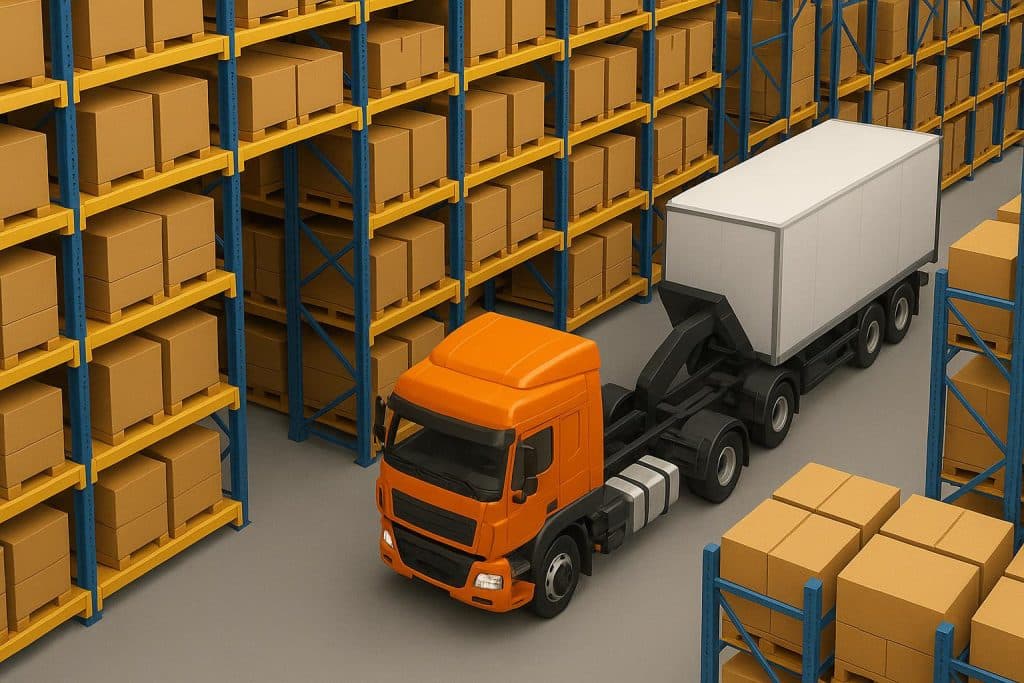Aisle width decides whether a warehouse feels effortless or exhausting. It shapes how fast pallets move, how calm operators feel during peak, and how much stock you can hold without renting overflow space. Most layout debates get stuck on cubic metres and lease costs, but the real lever is surprisingly simple. The aisle is where trucks either glide or stumble. Now, if the turning envelope shrinks, the layout can breathe. That is why the conversation so often begins with the truck you choose, whether that is a conventional forklift, a reach truck, or something designed to pivot where the work actually happens.
What changes when the truck turns differently
Conventional counterbalance machines prefer broad, forgiving corridors. Reach trucks can be more flexible, but we know that they still need room to straighten and slide.
An articulated design, however, changes the geometry at the sharp end. The pivoting mast allows the chassis to stay closer to the aisle centre, so the truck does not need to swing a long tail into the racking face.
The feel for operators is very specific. Instead of creeping to the bay and shuffling into line, they can commit earlier and make a single, composed movement. Less hesitation means less heat in the system when orders begin to spike.
In practice, your drivers now need much fewer micro-corrections, so the flow through a shift becomes smoother and you save very important time that’d be better utilised elsewhere. You’ve got next to no end-of-aisle congestion, and the layout team actually has options now. When aisles no longer demand a generous sweep, you can tune the plan around real work rather than around a worst-case turn.
And together, all 3 of these improvements signal the most important improvement for your business, which is maximum efficiency! And who doesn’t want that?
Aisle design isn’t just about space.
An aisle might look like a gap between racks. But anyone who’s spent a shift in a warehouse knows it carries far more weight than that.
A well-designed aisle defines how safely people move, how efficiently pallets turn, and how confidently operators handle pressure.
You see this in the small details. Clear lines at the aisle mouth so operators know where to start the turn. Mirrors at crossing points so no one relies on guesswork. Tidy end zones that are not used as a parking bay for cages and returns.
When those details are right, even modest changes to geometry feel stable rather than risky. People follow the line, trust their view, and keep their rhythm.
Don’t believe me? See it for yourself! A busy site put this to test and trialed narrower aisles over a weekend using tape and cones. It was nothing fancy. The team fixed two distracting floor joints, moved a bollard that stole sightlines, and refreshed the end-of-aisle paint.
The result? Everyone working that day remarked that everything felt less cramped and more direct, making their work hassle-free. And you know what? That actually led to increased productivity, backed by the numbers. The site manager was impressed. The warehouse owner was rich, in time and money.
That is what good geometry does. It turns tension into poise, which cuts your losses and increases your profits, without any pep-talks or speeches. Morale is important, but your workers don’t need a few words of motivation. They need you to make their work easier, so they can help your business more.
Your racking and your protection plan must talk to each other
Tighter geometry is unforgiving of tired infrastructure. If uprights are out of plumb or beams deflect more than they should, drivers feel it immediately.
So, before you commit to a new layout, make sure you’ve walked the frames with your inspection report and corrected any such distractors. Small fixes can restore the visual cues that help a driver judge clearance. That improves accuracy and removes the tendency to inch forward and back, which is what really steals time, and, not to forget, tires your drivers out.
This is also where you’d like to check how the pallet racking system interacts with real pallets, not brochure pallets. If some loads are slightly longer, more fragile, or more uneven than the standard pallet, design around the worst one you actually handle. Always plan for bigger and better.
Bringing the geometry back to people
Aisle geometry is not a theoretical exercise. It is a series of choices that add up to a behaviour your warehouse repeats thousands of times a day. You can make many data-driven decisions, and you should.
But ultimately, the best ones are the ones that’ll come from the people working your warehouses. They know where the gaps are, and trust me, they’ll also know how to fix them.
Practical geometry is a human art. Get that right, and you will discover that the most powerful upgrade often looks like a line of paint on the floor and a truck that turns exactly when you expect it to. That is the quiet, compounding promise of an articulated fork lift.


